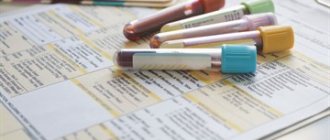The process called “platelet aggregation during pregnancy” is very important among those that occur in a woman’s body during this period of life. Explaining in simple words what this is, it should be noted that aggregation refers to the ability of platelet cells to connect plates of the blood type. If the phenomenon of increased aggregation or its decrease is observed, pregnant women are immediately prescribed certain therapy. If you do not start taking medications on time, certain problems may arise that will affect not only the course of pregnancy, but also the intrauterine condition of the child.
What is aggregation
The process of platelet aggregation during pregnancy is the gluing of cellular structures of the blood, resulting in the formation of a kind of patch that covers the damage and stops bleeding.
- First, the cellular structures of the blood stick together with each other, and then cling to the vascular wall. As a result of these processes, a clot is formed in the bloodstream.
- Normally, aggregation processes have protective tasks, because platelet cellular structures close the wound, stopping bleeding.
- But sometimes thrombus formation is extremely undesirable, because they block vascular channels in organs and systems of vital importance.
- Excessive platelet activity can lead to heart attack or stroke.
- With an insufficient number of platelets, the risk of various bleeding increases, which does not resolve for a long time, causing exhaustion and anemic conditions.
According to statistics, one in 250 patients die from thrombosis every year. To avoid such complications, it is recommended to monitor platelet levels and their aggregation. Doctors recommend undergoing diagnostic tests more often if you are prone to uterine or nosebleeds, with long-term healing injuries, with a tendency to bruise or with hyperedema.
Types of aggregation
There are several types of aggregation: induced and spontaneous, increased, moderate and low. Induced aggregation involves conducting research using inductor substances added to the blood plasma - collagen, ADP, ristomycin and adrenaline. A similar technique for determining aggregation is used in the diagnosis of blood pathologies.
Spontaneous aggregation is assessed without inducer components. Blood is taken from a vein into a test tube, which is then placed in an environment with a temperature of 37°C. High aggregation provokes excessive thrombus formation, which is manifested by increased swelling and a feeling of numbness in the limbs. The moderate form is characteristic of platelet aggregation during pregnancy and develops against the background of the active formation of placental circulation. Low aggregation is typical for pathologies of the circulatory system. With this form, a woman constantly experiences some kind of bleeding. Happens to girls during menstruation.
Etiology of thrombocytopathy
This set of diseases has a hereditary and acquired nature. According to medical statistics, about 10% of the total population of the planet have this pathology. The main characteristic of thrombocytopathy is a functional disorder of blood cells in the process of accumulation of certain blood substances.
Essentially, this is the inability of blood to clot due to the absence of a formed blood clot, which causes external and heavy internal bleeding.
The first signs of the pathological process begin to appear in childhood, and have a clinical picture of long-term non-healing wounds, large swelling at the site of minor bruises. In girls, the presence of thrombocytopathy is expressed in long-term and heavy menstruation. The result of pathology is the development of anemia.
The first signs of blood clotting appear in childhood
The inactivity of blood cells to form blood clots can be caused by a severe viral or infectious disease, as well as by regular use of certain medications.
Secondary thrombocytopathy
The causes of thrombocytopathy are leukemia, pernicious anemia, and the development of myeloma. It is also observed in renal failure and disruption of the endocrine system.
Other causes of secondary thrombocytopathy:
- Atherosclerosis.
- Hypertension.
- Heart attack.
- Formation of blood clots in the arteries of the abdominal cavity.
- Stroke.
- Diabetes.
How is aggregation defined?
Timely diagnosis will help detect pathology
The degree of aggregation can be assessed using a laboratory blood test. This diagnosis helps to identify signs of increased platelet formation processes, assess whether a girl’s platelet level is normal or exceeds the norm. Also, an aggregation analysis is indicated for monitoring the effectiveness of treatment for various blood pathologies, etc. Venous blood is taken for the study. In order for the study to show true results, you need to properly prepare for the diagnosis.
First, you need to follow the diet recommended by the specialist who ordered the analysis. 8 hours before diagnosis, the girl must exclude fatty foods from her diet and stop taking medications. And the day before the diagnosis, you need to give up cigarettes, garlic and alcohol, coffee and taking immunostimulating drugs. If all recommendations are taken into account and followed, the diagnosis will be reliable.
Venous blood sampling must be carried out on an empty stomach, early in the morning. Before the test, you are allowed to drink only plain water and in moderation. After blood collection, various inducers are added to the plasma or the study is carried out without any chemicals. Aggregation is determined by passing waves of light through the blood before and after it clots. The results reveal normal platelet counts, hypo- or hyperaggregation.
List of examinations to obtain results
- general blood analysis;
- coagulogram;
- taking anamnesis;
- additional examinations to detect secondary thrombocytopenia.
Attention! When preparing for tests, it is necessary to take into account all the recommendations of the attending physician so that the final results are error-free. To do this, you need to stop taking aspirin medications a week before donating blood, not eat fatty foods 12 hours before the examination, not do physical activity, be in a calm state, and not be nervous.
A blood test for platelet aggregation is prescribed by the attending physician if it is necessary to administer anticoagulants, when selecting the optimal dosage and effectively diagnosing increased bleeding.
We invite you to familiarize yourself with: Test for hemostasis during pregnancy (deciphering)
A blood test for platelet aggregation is prescribed by the attending physician if it is necessary to administer anticoagulants, when selecting the optimal dosage and effectively diagnosing increased bleeding.
Girls, maybe someone understands it, take a look! Long story short, with my second pregnancy my blood flow is again compromised. 1a degree for now. The geneticist advised me to take a hemostasiogram to check the thickness and viscosity of the blood. Today I donated it - Based on the results, the hemosthesiologist said that yes, indeed, the blood is thick, as evidenced by the increased rate of platelet aggregation.
Hypoaggregation
A reduced degree of aggregation is quite dangerous for patients, especially during pregnancy.
- Against the background of hypoaggregation, thrombocytopenia develops, associated with poor blood clotting.
- As a result, blood clots do not form, which leads to severe bleeding.
- Hypoaggregation can be acquired or hereditary and occurs in approximately 10% of people.
- Typically, the causes of this condition are a bacterial or viral infection, treatment with medications, physiotherapeutic procedures, etc.
- Hypoaggregation is typical for renal failure and chronic leukemia, anemia or insufficiency of thyroid function.
In order not to encounter such a blood pathology, you need to carefully consider your diet, which should contain foods that improve hematopoiesis. These include buckwheat and red meat, eggs and fish, beef liver or greens, beets and carrots, rose hips and bananas, chokeberries or pomegranates. But products such as garlic, citrus fruits and ginger must be completely excluded from everyday consumption.
To ensure that the platelet count corresponds to normal values, patients are prescribed the drugs Dicynon and Emosint, Tranexamic acid or sodium adenosine triphosphate, aminocaproic acid. If the bleeding is very severe, then a transfusion and exclusion of blood thinning drugs such as aspirin or Troxevasin, Ibuprofen or Paracetamol, antidepressants and Eufillin are necessary.
Research methods
The method for determining the indicator depends on the laboratory and the type of aggregometer. The reliability and value of the research results obtained does not depend on the chosen methodology. The most popular methods are the use of solutions of adenosine triphosphate, ristocetin, collagen, adrenaline and arachidonic acid. Let's take a closer look at the essence of each technique.
Adenosine triphosphate method
After receiving the test result, patients ask themselves: what does platelet aggregation with ADP mean? Explanation of the abbreviation ADP - adenosine triphosphate. It is known that a small amount of ADP causes platelets to become activated and subsequently stick together. The process is characterized by a two-wave flow. The first stage of aggregation occurs due to the action of ADP. The secondary wave begins after the release of specific molecules (agonists) from platelets. When adding a large amount of ADP (more than 1*10 -5 mol), it is not possible to detect the separation of the two phases, since they merge.
When performing the study, specialists pay special attention to the number of waves, completeness, speed and reversibility of the process. Detection of a two-wave process at small doses of ADP is a sign of increased sensitivity of platelets. Reversible and incomplete platelet aggregation with ADP-1 indicates failures in platelet activation.
Method with ristocetin
The study is carried out to quantitatively determine the von Willebrand factor in the patient being examined. This is a hereditary pathology characterized by disturbances in the process of blood clotting.
The method is based on the direct effect of ristocetin on the interaction between the factor and the glycoprotein. Normally, ristocetin has a stimulating effect on this process. This effect is not observed in patients with hereditary pathology.
It is important to carry out a differential diagnosis, since von Willebrand disease is similar to Bernard-Soulier syndrome. This is a hereditary pathology, against the background of which a person’s platelets completely lose the ability to perform their functions. However, after adding a deficient clotting factor (for von Willebrand disease), platelet aggregation is restored in patients. For Berne-Soulier syndrome, such recovery is not possible.
Collagen method
A distinctive feature of aggregation with collagen is a long latent phase necessary for the activation of the phospholipase enzyme. The duration of the latent phase varies from 5 to 7 minutes and depends on the concentration of collagen used.
After this phase is completed, platelet granules are released and thromboxane is produced. As a result, interaction and adhesion between platelets increases.
Adrenaline method
The effect of adrenaline on platelet adhesion is similar to the effect of ADP. The process is characterized by a two-stage process. It is assumed that adrenaline is able to directly affect platelets, increasing the permeability of their cell wall. Which leads to increased sensitivity to released specific molecules.
Arachidonic acid method
Acid is a natural catalyst for the process of cell gluing. She is not able to directly influence them. Arachidonic acid exerts its effect indirectly through enzymes, secondary messengers and calcium ions.
The aggregation process is rapid, usually in one stage. This type of research is relevant when the patient is taking medications.
Hyperaggregation
Any medications are taken only under medical supervision
If aggregation processes increase, active thrombus formation begins, blood begins to flow more slowly through the venous channels and quickly coagulates. Typically, this condition is typical for thrombocytopathies, vascular atherosclerosis or hypertension, as well as diabetes or oncopathology in the blood, gastric or renal tissues. As a result of hyperaggregation, the risk of strokes, heart attacks or venous thrombosis increases. If the pathology is ignored, death can occur.
Treatment is based on taking blood thinners like regular aspirin, which is recommended to be taken after meals. Proper selection of a treatment regimen will help avoid the appearance of new blood clots. Patients are prescribed painkillers, vasodilators and anticoagulant drugs.
Symptoms and consequences of the disease with low antibody levels
The main symptoms include, firstly, hemorrhage in the skin, which can occur spontaneously, when a minor injury can cause significant hemorrhage, secondly, gums begin to bleed after each brushing of teeth, thirdly, ear and gastrointestinal bleeding, which leads to exhaustion and anemia.
Consequences of the disease with increased levels of blood platelets:
- The risk of heavy bleeding during childbirth increases.
- The development of bleeding in the body of a newborn.
If platelets are enlarged, this can lead to the development of arterial and venous thrombosis. This syndrome in most cases leads to spontaneous miscarriages in the early stages.
Features of aggregation processes in pregnant women
The aggregation rate is very important for pregnant girls. If these processes proceed with disturbances, then this can lead to serious complications for the baby and pregnancy. Small increases in indicators are caused by the formation of placental blood circulation and is a completely normal phenomenon. But sometimes aggregation can occur with disturbances, for example, with hyper- or hypoaggregation.
The state of hyperaggregation is dangerous for the fetus, because it can provoke spontaneous abortion or miscarriage. The main causes of hyperaggregation in pregnant women may be factors such as:
- Dehydration of the body due to frequent stools, insufficient fluid intake or severe toxicosis, accompanied by vomiting.
- Pathologies that can cause an increase in platelet cells.
To avoid hypercoagulation, a pregnant woman should regularly undergo tests prescribed by the gynecologist and undergo examination. This is the only way to detect abnormalities in the blood composition in a timely manner and take the necessary measures to eliminate them. If the aggregation rate in a pregnant woman is moderately exceeded, then the situation can be corrected by simply adjusting the daily diet. It is necessary that blood thinning products such as tomato juice, olive or flaxseed oil, onions, etc. be present on the menu every day.
In addition, mommy needs to eat more foods containing magnesium, which include legumes and eggs, cereals (buckwheat, oatmeal, etc.) and milk. If diet therapy does not produce the desired results, then treatment with medications is indicated.
Fresh juices are very useful during pregnancy
If a pregnant girl’s rate of platelet aggregation is too low, then hypoaggregation develops, which is no less dangerous for the baby and the mother than active platelet aggregation. In such conditions, the vascular canals become fragile, numerous bruises form, and gum bleeding begins. Experts associate such phenomena with a deficiency of platelets, and those that are available are of poor quality. Against the background of hypoaggregation, uterine bleeding develops during pregnancy, during or after delivery.
Hypoaggregation can be promoted by taking antibiotics or diuretics, endocrine or autoimmune pathologies, an unhealthy diet and pronounced toxicosis, vitamin deficiency or allergic reactions. To improve platelet production, a pregnant woman is recommended to eat more currants, cabbage and apples, sweet peppers or lemons, and drink rosehip infusion. If necessary, the doctor prescribes drug therapy with drugs that have a beneficial effect on the hematopoietic system.
Normalization of blood platelet levels
Many people are concerned about the question “how to increase platelets in the blood?” Treatment should be prescribed by a doctor after a thorough examination and determination of the cause of the disease.
A mild degree of the disease does not require special therapy; to correct it, it is necessary to improve nutrition and eliminate harmful factors (smoking, alcohol, stress).
Treatment of severe and moderate (in the presence of risk factors) thrombocytopenia should take place in a medical institution. The therapy uses drugs such as prednisolone, etamsylate, vitamin B12 and many others.
Traditional ways to increase platelets
With a slight decrease in the number of blood platelets in the blood, they can be increased using folk remedies. Buckwheat porridge, red meat, beef liver, fish and eggs have proven themselves well.
Sesame oil, which should be consumed 1 tbsp, will also help raise the level of platelets in the blood. l. 3 times a day (before breakfast, lunch and dinner).
Normal platelet count during pregnancy
Normal aggregation rates for pregnant women are somewhat different from generally accepted aggregation rates. The generally accepted norm is an aggregation index of 150-380*109/l. When conducting diagnostics using the inductor method, indicators of about 30-60% are normal for pregnant women.
Platelet aggregation is one of the most important indicators for pregnancy, responsible for the proper adhesion of platelet cells. Although during pregnancy, another circle of blood circulation is added to the patient’s body, so the blood volume increases, and because of this there are fewer platelets. If the content of platelet cells falls below 140 thousand/μl, then pathology is diagnosed.
A normal phenomenon is considered to be a deviation of platelets in pregnant women from non-pregnant women by approximately 10-20%. All this is quite understandable from a physiological point of view. But when the platelet count is excessively low or high, a dangerous situation arises, so it is very important to identify such conditions in a timely manner. If difficulties arise with diagnosis, then consultation with a qualified hematologist is necessary, who can determine the exact cause of the deviations.
Correction and prevention of aggregation
If detected in a timely manner, aggregation can be successfully adjusted in the right direction.
- If aggregation processes differ in slight deviations in any direction, then diet therapy is prescribed, with the obligatory consumption of foods rich in ascorbic acid.
- In addition, it is useful to eat flaxseed oil or olive oil.
- Also, to normalize platelet levels and the degree of aggregation, pregnant women are advised to use gentle preparations of homeopathic origin that are safe for the baby.
- Any medications for pregnant women are prescribed only by a doctor and after a full examination, in order to exclude the presence of possible contraindications.
- In cases of severe hyperaggregation, the use of antiplatelet and anticoagulant drugs that are safe for pregnant women is indicated.
- To avoid possible problems with aggregation and platelet levels, a woman needs to take lifestyle and preventive measures seriously.
- A girl should drink about 2 liters of liquid per day, including freshly squeezed juices and drinking water, lemon juice or freshly prepared smoothies, etc.
- It is recommended to eat at least 5 times a day, but in moderation, avoiding high-calorie foods.
- It is also useful for mommy to do gymnastics for pregnant women, walk more outdoors and do gymnastic training in the pool.
- A prerequisite is the timely completion of examinations and tests prescribed by the doctor.
If there is the slightest change in platelet aggregation during pregnancy, it is necessary to take preventive measures in a timely manner so that there are no problems with pregnancy and the child is safely delivered to term.











